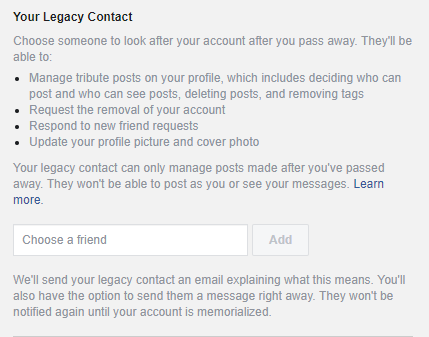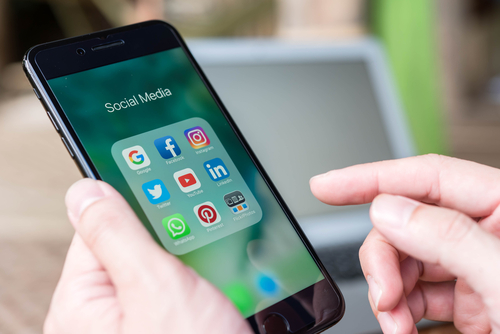11/19/2019 E-Newsletter: Your new keyboard may give you a virus… | Protect your children from adult advertising
Extremely important! Learn how to keep your computers safe from junk and viruses. Also, who gains access to your accounts after you pass away? Read this to learn how that works. More scams coming to your inbox. Don’t fall for fake debt collectors. Click here to read all this and more!Read More
08/01/2019 E-Newsletter: FaceApp – stealing your info? What is SSL and why do I need it?
Extremely important! Learn how to keep your computers safe from junk and viruses. Also, who gains access to your accounts after you pass away? Read this to learn how that works. More scams coming to your inbox. Don’t fall for fake debt collectors. Click here to read all this and more!Read More
07/11/2019 E-Newsletter: Slow computer? Let’s fix that. Fake debt collector emails
Extremely important! Learn how to keep your computers safe from junk and viruses. Also, who gains access to your accounts after you pass away? Read this to learn how that works. More scams coming to your inbox. Don’t fall for fake debt collectors. Click here to read all this and more!Read More
06/27/2019 E-Newsletter: Business Social Media Reputations and Free Wi-Fi Worries
Wait! Know the risks before connecting to public Wi-Fi. Get an email asking you to update your 1&1 Ionos account information? We did too, luckily we were able to tell it was a SCAM. Lastly, we helped garner hundreds of job applications easily. You can too!Read More
Social Media After Death
 As of this year, at least 2.34 billion people worldwide are social media users. In the United States alone, 79% of people have a social media profile. Something we don’t really think about when signing up for these accounts is what will happen to them when we pass away. Should we write your passwords down somewhere? Can someone gain access to them after we’re gone? What happens to your social media after death? It is reported that around 8,000 Facebook users die every day. It’s important that policies and protocols are put into place.
As of this year, at least 2.34 billion people worldwide are social media users. In the United States alone, 79% of people have a social media profile. Something we don’t really think about when signing up for these accounts is what will happen to them when we pass away. Should we write your passwords down somewhere? Can someone gain access to them after we’re gone? What happens to your social media after death? It is reported that around 8,000 Facebook users die every day. It’s important that policies and protocols are put into place.
Facebook & Instagram
Facebook and Instagram are the only major social media platforms that “memorialize” your account.

With Facebook, you can set up a “legacy contact”. This is the person who will manage your account after you’re gone. To set up your legacy contact, go into your Facebook general settings and select Manage Account and choose the person to take this role. As seen in this screenshot, the person you choose to be your legacy contact will not be able to post as you or read your messages. If you don’t want to have a legacy contact, you can also request for your account to be deleted when the time comes. To request for an account to be memorialized, contact Facebook here.
Instagram does things a little bit different. There is no legacy contact that can manage your account for you when you die. Once a family or friend sends a report and the account is memorialized, it appears mostly the same. However, the account will not show up as a recommendation anywhere on the app (such as in the explore section). Nothing can be deleted or changed on the account after it is memorialized.
Other Platforms
For most other social media platforms (including Twitter), there are no memorialized profiles, therefore a family member has to request the removal of a deceased user’s account. In general, social media platforms will never give login details to anyone but the account owner, even immediate family members. This would violate most terms of service. If you want someone to have full access to your social media, it may be smart for you to put this in writing with something like a digital will. This will hand over ownership of your accounts after you pass away. This helps avoid violating any terms of service.
Computers and Devices
That great password you’ve set up on your computer or device to keep others out will do just that after your death. As a rule, device manufacturers will not grant access to others to get around your pass codes and passwords. Keep in mind many of your online accounts also have 2-factor authentication too. Banks and other service providers are happy to work with whoever holds your power of attorney posthumously, but email accounts and other online accounts will need to be accessed with the information you leave in your digital will.
Though it may be odd, it is important to have a plan for what happens to your social media and online accounts after death. Set up your legacy contact on Facebook today. Also, inform your friends and family by sharing this with them! Subscribe to our bi-weekly e-newsletter for more helpful information like this!
Maintaining Your Company’s Social Media

Being active on social media is almost required to run a successful business these days. We also know that it can be difficult to gain and maintain an active following. This is why it is extremely important to make sure you create and approach your social media accounts in a professional manner.
Creating Business Social Media Accounts
One of the most important things to do when creating profiles for your business is to use a business email address (for example: marketing@companyname.com). Do not allow an employee to use their own email when setting up social media accounts. We’ve seen companies let go of employees and lose access to accounts because they hadn’t been set up using a business-owned email address.
Employee retaliation can even result in the account being deleted with no option for recovery. This means you would lose access to the audience you worked so hard to build up. You’ll have to start all over which can be a large waste of time and money. Make sure to use a company email and keep track of your passwords!
Posting to Your Business Social Media
Nowadays, there are too many social media platforms to keep up with. It is time-consuming to jump from platform to platform and make individual posts. Thankfully, there are tools available which make this process much faster and easier. Using a program like Hootsuite helps by enabling you to schedule posts to almost any social media platform from one location, all at the same time. It will also allow you to schedule posts out for days when you aren’t going to be at the office. Scheduling ahead like this also gives you time to proof each post before it goes live. You can even send the draft around internally to get another set of eyes on it before any embarrassing mistakes go out to your audience. If Hootsuite isn’t your cup of tea, there are many other alternatives for you to choose from.
Having Social Media Guidelines
Making sure you have a company social media policy in place is important. Your social media policy should outline that an employee’s online activity reflects on the company and employee. It should remind employees of your company’s privacy and confidentiality rules. Setting rules in a policy ensure that nothing gets posted that shouldn’t. Your policy should educate and train your employees about using social media on behalf of the company while presenting a consistent corporate image. Keeping your posts on-brand and relevant will help them stand out from the crowd.
Conclusion
To maintain the security and longevity of your social media accounts, make sure they are created with company credentials. Use a scheduling program like Hootsuite to plan and proof posts before they go live. Lastly, have a clear social media policy in place to ensure the appropriateness of the content being posted. You can always call in a professional to handle your company’s social media. Appletree MediaWorks has an on-staff Social Media Specialist that is experienced in managing social media accounts for businesses like yours.
Get weekly tech tips and helpful products by subscribing to our bi-weekly newsletter for free (at the top of the article)!
Mobile Friendly Websites Are A Must
Mobile Friendly Websites Are A Must
It’s official – internet traffic from mobile devices has surpassed traffic from desktop systems. That may or may not surprise you. If you need help suspending your doubt, simply open your mobile’s app library. You’ll soon notice that a vast number of apps rely on internet access to varying degrees. From social media platforms to workplace productivity applications, more and more of the global digital landscape is trending toward mobile-first usage. As this trend continues, ensuring your website is mobile friendly is more vital to your success than ever before.
Social Media And Mobile Traffic
Love it or hate it, social media has had a profound influence on the traffic shift from desktop to mobile. Two platforms – Facebook and YouTube – presently make up over 30% of mobile traffic. Though the day’s preferred platform is constantly in flux, people are spending more time on social media overall. Every major social media hub is geared toward mobile-first access. For example, have you ever tried using Instagram on a proper computer? Better yet, you’ll need a pile of good luck to send your next snap story from a computer, as SnapChat is mobile-exclusive as far as real usage is concerned. This increased attention on social media is impacting time spent on mobile devices. Meeting your customers where they spend time is common sense in the world of business marketing. Don’t focus on desktop tuning while your next customer is checking out the competition from their smart phone.
Similarly, social media has become a powerful tool for brand engagement and customer relations. Consumers expect the brands they support to be attuned to their needs and wants, and assume they can easily move between the digital places controlled by those brands. Part of that assumption is derived from the expectation that websites can be easily navigated on mobile devices. According to a 2016 study conducted by Google, 53% of mobile customers will abandon a website if it takes more than 3 seconds to load. Accordingly, this has a direct affect on a site’s bounce-rate and packs a punch when looking at search engine ranking results.
Mobile Online Buying and Selling
For e-commerce sites, mobile optimization is crucial to success. Large retailers like eBay and Amazon have even developed mobile apps to allow users to easily access every feature of their site! Seamless shopping allows customers to add an item to their cart on a desktop and complete the purchase from a hand held device. Mobile optimized sites streamline the purchase process and encourage shoppers to spend more. Nearly 8 in 10 mobile shoppers report spending more time and making more impulse buys on device friendly websites.
Trends to Consider for Mobile Friendly Sites in 2018
Beyond the numerous reasons to optimize your website for mobile, it is essential to understand how to make the most of it:
- Your text should be easily readable and simplified to target your customers. Zooming in to read long chunks of irrelevant copy will quickly exhaust a user’s patience.
- Consider how mobile users will interact with your website. Desktop and laptop users enjoy the luxury of mouse navigation. Mobile displays require large buttons and scrolling column layouts to allow for quick and easy exploration.
- Page load speed is crucial. Users expect immediate information from their mobile devices. Your customers will flee if your page takes more than 3 seconds to load.
- Photos and Images Should be Prominent and High-Quality. The images you use should be relative to your content and used sparingly. Images also attract and retain attention, so high-quality images are crucial.
Stop waiting to fine tune your website for mobile navigation – just do it!
Reach out to us today to learn more about making your website mobile-friendly.
Social Media Copyright Issues: Fair Use or Infringement?
Social media copyright issues have become a hot topic in recent months. Nearly everyone has shared something on social media that was copyrighted by someone else. But what is fair to use on social media and what infringes on the rights of the copyright holder?
Is it fair use or infringement?
If you do not get a license from the copyright holder then the only way to use the content is through something called “fair use”.
What is fair use?
Generally, fair use covers any copyrighted material that was shared with a “transformative” purpose. This might constitute a comment, criticism, or parody accompanying material. Such sharing can take place without permission from the copyright owner.
Categories of Fair Use
- Commentary and Criticism – Commenting upon or critiquing copyrighted material. Examples include online reviews, news reports, education courses, or court case.
- Parody – A parody takes copyrighted material and ridicules it in a comedic way.
Fair Use Checklist
Not sure if you’re allowed to share something under “fair use”? Run it through this checklist to be sure before you post.
☐ Purpose and Nature of Use
The use of copyrighted material must be “transformative”. This means you took the time to add new meaning or value to the copyrighted material with new information, aesthetics, insights, or understandings.
Example of Fair Use: Google images – All Google images are copyrighted by the owner. Google’s use is considered “transformative” because it displays pictures in a different way, for a new purpose.
Example of Fair Use: Scary Movie Series – This movie series is a parody which borrows copyrighted material in order to ridicule it. Producers added value using new information, aesthetics, insights, and understandings.
Example of Infringement: Posting a copyrighted image on social media is for aesthetic or entertainment purposes. This is likely NOT a different use than the copyright holder intended and does not transform the work.
☐ Nature of the Work
Using copyrighted information has more leeway in fair use than copyrighted creative works. Also, there is more leeway in using published work rather than unpublished work.
☐ Amount and Substantiality of the Portion Used
Less is more. Meaning the less you use of the copyrighted material the more likely it will be considered fair use.
Exception: Using the most memorable (although small) part of a copyrighted work, such as the opening riff of “Sweet Child O’ Mine” by Guns N’ Roses.
Exception: Parodies – Quite a bit of a copyrighted material, even the heart of the material, can be used for parody. The Supreme Court acknowledges that “the heart is also what most readily conjures up the [original] for parody, and it is the heart at which parody takes aim,” as decided in Campbell v. Acuff-Rose Music,510 U.S. 569 (1994)
☐ Effect of Use Upon Market or Value
If you deprive the copyright holder income or undermine copyrighted work that could have potential market it is not fair use and you are most likely looking at a lawsuit. This holds true even if you are not using the copyrighted work directly.
Example of Infringement: An artist used a copyrighted photo to produce wood sculptures and earned a lot of money selling them. Even though the photographer did not plan on make sculptures it was considered a potential market and the court ruled in favor of the photographer.
[alertbox color=”blue”]MYTH
If you list a source, using copyrighted material is permissible.[/alertbox]
This is probably the most popular myth about copyrighted material. Even if you list your source, using copyrighted work without permission is still an infringement, especially if you are making income from it.
☐ Check Original Source
Sometimes the original source will have copyright notices. If you are unsure, be safe and obtain a license from the copyright holder.
 ☐ Check Social Media Terms and Conditions
☐ Check Social Media Terms and Conditions
When someone posts original work on social media, you should check the authorization to re-post, re-tweet, or re-pin that content. Read our blog article Social Media Content Rights for more detail.
Example: Pinterest’s term of service states that if a user posts content on Pinterest they are providing a license to all other users to use that content on Pinterest.
☐ Post a link instead of content
On social media, post a link to the original source of the material instead of the material itself. While this is still infringement, the chances of a complaint are much lower (especially since everyone does it). This does support a fair use defense.
☐ Keep Sharing Within Network
When you find content on social media you want to share, keep it within that network. Always read the terms and services before sharing.
[alertbox color=”blue”]
MYTH
Content posted on social media is fair game.
[/alertbox]
Some may think that if the content is on social media then it is fair game to use. This is not the case – the copyright still belongs to the copyright holder.
 You can be held at fault for posting copyrighted material or even sharing something someone else posted that was copyrighted. This seems to happen so frequently on social media that the chances of litigation are low, but it’s still a risk.
You can be held at fault for posting copyrighted material or even sharing something someone else posted that was copyrighted. This seems to happen so frequently on social media that the chances of litigation are low, but it’s still a risk.
U.S. Copyright Office Fair Use contains comprehensive information if you’d like additional information.
Why Businesses Should Be On Social Media
Social Media is Valuable to Businesses
So you already have a website. Do you need to bother with social media? The answer is yes, and the obvious reason is that it makes your business easier to find. But there’s more to it than that! Read on for why businesses should be on social media platforms like Twitter, Facebook, and Google Plus.
Closer and More Personal Relationships With Customers
People like to feel important and they want to be heard. By using social media you have a major advantage in knowing what your customer wants, what they like, and how they speak.
And you are in an optimal position to speak back to your customers and engage in dialogue. You are not selling something as much as participating in an interactive community. This kind of interaction makes your company feel more human.
Instant Feedback – And Damage Control
 If someone is unhappy with a product or service, these days they often bring their experience straight to the internet, in a public and vocal way.
If someone is unhappy with a product or service, these days they often bring their experience straight to the internet, in a public and vocal way.
This puts the spotlight on you to respond, and is your opportunity to turn lemons into lemonade. If someone is complaining, it’s because they want to be heard. Your properly-handled response to complaints can create dedicated followers and loyal customers.
Just remember not to be emotional or hostile when you respond to criticism – all eyes are on you to see what you do!
Learn About Your Customers & Expand Your Audience
When you get feedback from your customers you are gaining valuable data: their opinions, their preferences, what drives them, and how they operate.
This information is valuable, in that it gives you a greater opportunity to expand your audience and find more customers.
Create Interest and Awareness – For Less Cost Than Traditional Media
If a potential customer doesn’t know you offer a particular good or service, they won’t think to go to you. If they see what you have to offer even when that is not something they’re searching for at this exact time, you’ve still made them aware of it. Because of that, when they do need what you offer, they know you’re an option.
Creating awareness and interest through social media does take time. But it costs significantly less than traditional media. That’s not to say you should give up on traditional media, but at the very least social media is a worthy supplement.
Share Your Content & Bring People Back to Your Website
Do you have blog articles, photos, imagery of your services on your site? Social media is a great way to get that info out for people to see. It’s also a great way to bring people back to your website.
Your website should be the hub of your internet presence that users can come back to for all things about your company. Social media is a great supplement. It allows for personal interaction, draws people to your website, and helps create conversation about your business. Take a look for more obscure social media outlets as well. Platforms like Tumblr, Alignable, Instagram and even Ello may have something to offer.
If you need help setting up your web presence, contact us at Appletree MediaWorks – we can give you a hand.
Social Media Content Rights
 Who Owns Rights To Your Social Media Content?
Who Owns Rights To Your Social Media Content?
Occasionally we see those posts on Facebook where a user declares that they don’t have to abide by Facebook’s terms of service, having written a clause in a post. We all know this is a hoax. After all, you already agreed to their terms by making an account.
Even so, what is the nature of your media on someone else’s social media network? What are your social media content rights? It varies, and it’s murky.
Facebook:
 Facebook’s terms are broad. Since their (and your) materials are hosted on various servers, their terms are written so that the data can be shared as desired or needed by them. According to Scoopshot, this does not end when you delete your account either. Your images may be hosted on one of their servers elsewhere.
Facebook’s terms are broad. Since their (and your) materials are hosted on various servers, their terms are written so that the data can be shared as desired or needed by them. According to Scoopshot, this does not end when you delete your account either. Your images may be hosted on one of their servers elsewhere.
Facebook says they have no intention of using these images for their own purposes, selling them, or otherwise distributing them. However, their legal terms are written so that they can.
Read Facebook’s Terms of Service
Don’t like it? Don’t host or post your media there.
Twitter:
 Media you post on Twitter stays yours, says Twitter, but their terms specify that they can distribute the materials posted through them. Again, their terms are open-ended.
Media you post on Twitter stays yours, says Twitter, but their terms specify that they can distribute the materials posted through them. Again, their terms are open-ended.
Twitter’s Terms of Service state “By submitting, posting or displaying Content on or through the Services, you grant us a worldwide, non-exclusive, royalty-free license (with the right to sublicense) to use, copy, reproduce, process, adapt, modify, publish, transmit, display and distribute such Content in any and all media or distribution methods (now known or later developed).”
Instagram:
 Your material belongs to you on Instagram, with the usual warnings about network sharing. They can display those images as they see fit. You are also responsible for not hosting copyright materials belonging to someone else.
Your material belongs to you on Instagram, with the usual warnings about network sharing. They can display those images as they see fit. You are also responsible for not hosting copyright materials belonging to someone else.
The terms of service for Instagram state “you hereby grant to Instagram a non-exclusive, fully paid and royalty-free, transferable, sub-licensable, worldwide license to use the Content that you post on or through the Service, subject to the Service’s Privacy Policy, available here including but not limited to Sections 3 (“Sharing of Your Information”), 4 (“How We Store Your Information”), and 5 (“Your Choices About Your Information”).”
Flickr:
 Flickr is owned by Yahoo, and there has been a lot of fuss over who owns those images. Currently, Flickr claims that you own the rights to your images in their social media network.
Flickr is owned by Yahoo, and there has been a lot of fuss over who owns those images. Currently, Flickr claims that you own the rights to your images in their social media network.
Other social media networks state that you own your media with the usual server/host limitations. They also assume that you are acknowledging that you own the materials you upload.
Ultimately, social media networks are going to cover all their bases for the foreseeable future, and make sure they are covered legally. This generally means they will broadly define their own rights. The result may be that they are allowed rights to your media. Your option, then, is to think carefully about where you are posting your media.













